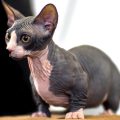The number of elf cats – the original breed for lovers of hairless cats, is constantly growing every year. Along with the well-known Canadian Sphynx, new breeds are appearing, which are even more interesting on the exterior.

The hallmark of the elf cat and its main difference from other hairless cats is the shape of their ears. The tips of the ears are bent back, which gives the cat the appearance of a fabulous mythical creature from Celtic epics. It received its name precisely because of this feature in this breed.
The history of appearance Elf cat
The impetus for the creation of a new breed was a sad event. Kristen Leedom, a famous breeder of Canadian Sphynxes, pet fell seriously ill. The woman tried everything to help her cat, but all her attempts failed.
On this sad note, she came up with the idea of breeding hairless cats, which would be characterized by increased immunity, endurance and excellent health. Kristen told her friend, Karen Nelson, also an experienced breeder, about her intentions.
No felinologist will approve of crossing different registered breeds because there is a high probability of genetic diseases and mutations. However, Kristen took a chance and tied the Canadian Sphynx and American Curl.

Because of her painstaking breeding work, it created the Sphynx elf – a cat that inherited hairlessness and basic external data from its bald producers, and its remarkable health and funny ears from curls.
In 2006, the International Cat Association (TICA) registered the elf as an experimental breed, but no felinological organization recognizes it as a separate and officially registered breed.
Description and breed standard
Cat breeds such as the elf has its own distinct personality. It cannot be confused with any other breed. Much of the appearance was taken from sphynxes.
They have a graceful, flexible body with well-developed muscles.
Elves are considered a large breed, but this is not evident due to the lack of fur. The weight of a mature adult cat can reach 8 kg; cats are slimmer, more graceful, and rarely exceed the threshold of 6 kg.
The body shape resembles a drop or a pear; the sagging belly is not considered a pathology or an issue.

The legs of this cat are strong and sinewy and are tightly pressed against the body. The ulnar joints are laid back, which makes a sitting cat resemble a gargoyle from Notre-Dame de Paris. The front legs are longer than the rear, allowing elf cats to move more smoothly and gracefully than the Sphynx.
A long and thin tail, similar to a rat, complements the fabulous image.
The head of this breed is wedge-shaped with pronounced cheekbones and whisker pads.
For most elves, eyebrows and vibrissae (whiskers) are absent, but the standard permits and allows their presence.
The ears are the main talking point about the description of the breed. They are large, wide, and pointed at the ends. The tip of the auricle is arched back, which gives an unusual appearance of the ear shape.
The eyes of the elf attract attention from the first few seconds you meet it. They are big expressive and look very smart. The eye was shaped as an almond. The colour may differ: blue, olive, yellow, and walnut. Often, there are odd-eyed specimens.
The elf is a hairless cat, her skin is hot to the touch, and it feels like cashmere to the touch. The standard allows the presence of soft, like fluff, fur on the tips of the paws and ears, and also on the tail and the sides of the body. Often, the fluff appears with age or in cold weather.
The elf’s coat color can be of any type: white, peach, dark gray, blue, tortoiseshell. Some individuals have spots randomly scattered throughout their body.
Many consider bald cats hypoallergenic, but this is not quite true. This statement is true if a person is allergic to fur and not to the animal’s skin secretions.
The elf’s character and nature
The elf is an intellectual cat. She is naturally curious and thoughtful at the same time. Like Sphynxes, elves are very attached to a person, and they do not tolerate loneliness. Such a cat can be around you for hours without getting tired, watching all the household chores being done by the owner.
Goodwill is the main character trait of an elf. They are very affectionate but unobtrusive cats. Some owners say that the love of an elf is equally valid for all family members, while others have positioned the elf as a one owner cat.
It is also interesting how elves display warm feelings for humans. They like to sit on their owner’s lap, purring loudly, and they are able to wag their tail when they meet, like dogs.
The elf cat breed is the friendliest of all household felines. They do not have any problems with being together with dogs, rabbits, cats, rodents. As a rule, they quickly adapt to a new pet and do not show any aggression.

Many have noted that elves are vindictive. This feature is common to all cats; it does not wish to harm but expresses its discontent. This behavior can be provoked by the appearance of a new person or animal in the house, as well as a rude attitude against the cat.
In early childhood, elf kittens are very mobile and inquisitive, but with age, playfulness passes so that elves can be considered as pets with an average activity level and even a tendency to be lazy.
The elf is the perfect cat companion. The cat will be near the owner for many hours, walk behind him and wait at the door while the owner is at work. These cats are like little children who demand attention and become capricious if they don’t get it.
Upkeep and care
Elves are special house pets, demanding special treatment. First, lack of fur. Hairless cats should be kept warm as they do not tolerate draughts and cold temperatures.
In a cold room, they will climb on the owner’s lap in the hope of getting warm or take refuge under a blanket on the owner’s bed. There is special clothing made for hairless cats, to which they quickly become accustomed, and they will not try to resist wearing it.
The skin of all hairless cats should be regularly maintained. This consists of daily wiping with wet baby wipes, as well as bathing from time to time. Most elves love bath procedures and get great pleasure from them.
Ear care is also important. Due to the lack of hair inside their ears, which would protect them from dust and dirt, hairless cats secrete a large amount of sulfur. This should be removed regularly, using a cotton swab and special sprays.

Moreover, hairless cats need to get their claws trimmed so that they cannot get hurt. If you do these procedures from infancy, the cats will not have time to develop a negative attitude.
Elves can easily get used to the tray while still in the nursery. As a rule, they receive these parenting lessons from their mother. In adulthood, even neutered cats do not mark their territory, so the furniture and corners of your apartment should not be affected.
Their diet must be balanced, as these cats tend to get overweight.
There are products available just like for healthy cats: different types of meat, fish, cereals, vegetables, sour-milk products, fortified supplements. There is also special food for hairless cats.
The health of an elf cat
Elves can be called pets that do not have any special health issues. With poor skincare and poor nutrition, hairless cats can develop dermatological diseases.
Often, this manifests itself in the form of acne, pimples, suppuration, and irritation. When the diet is adjusted, these problems quickly disappear.
Acne can occur during puberty at the background of hormonal bursts. If adult acne does not disappear, the pet should be sent to a vet.
Timely vaccinations and deworming will protect your pet from many serious diseases. They must be done even if the pet does not leave the apartment. Deadly viruses can be carried on the soles of shoes, and helminth eggs can be present in raw fish or meat.
It is too early to talk about hereditary diseases since this is a very new breed. In general, they are considered strong and hardy cats. The average life span is 12-15 years and 17-18 years with the right diet and proper care.
How much does a hairless cat cost?
Because of its novelty and rarity, buying an elf kitten is quite problematic. Nurseries that breed this breed are still few, and prices are very high.
Elves can be paired with Canadian sphynxes. In this case, elf kittens emerge are born in 50% of all cases, and the rest of the kids in the litter inherit the Sphynx phenotype. The most expensive are specimens obtained inside the same breed.
Dwelf
Subspecies of an elf cat breed can be dwelf cats. These amazing animals got their name as a derivative of two words: Dwarf cat and Elf (fabulous being from folklores of other people).

Dwelfs are distinguished from their closest relatives by their short paws. This feature is the result of the crossing between Canadian Sphynxes, American Curls and Munchkins. Specifically, the last ones gave dwelfs the short-footed gene.
This breed is very new; the first representatives appeared only in 2009. The hairless short-legged cats are not yet recognized by the international felinological associations and are considered an experimental breed. Although, judging by their incredible popularity around the world, recognition is just around the corner for them.



